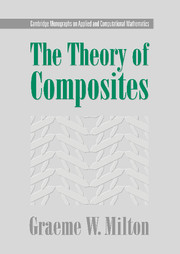Book contents
- Frontmatter
- Contents
- List of figures
- Preface
- 1 Introduction
- 2 Some equations of interest and numerical approaches to solving them
- 3 Duality transformations in two-dimensional media
- 4 Translations and equivalent media
- 5 Some microstructure-independent exact relations
- 6 Exact relations for coupled equations
- 7 Assemblages of spheres, ellipsoids, and other neutral inclusions
- 8 Tricks for generating other exactly solvable microgeometries
- 9 Laminate materials
- 10 Approximations and asymptotic formulas
- 11 Wave propagation in the quasistatic limit
- 12 Reformulating the problem of finding effective tensors
- 13 Variational principles and inequalities
- 14 Series expansions for the fields and effective tensors
- 15 Correlation functions and how they enter series expansions†
- 16 Other perturbation solutions
- 17 The general theory of exact relations and links between effective tensors
- 18 Analytic properties
- 19 Y-tensors
- 20 Y-tensors and effective tensors in electrical circuits†
- 21 Bounds on the properties of composites
- 22 Classical variational principle bounds
- 23 Bounds from the Hashin-Shtrikman variational inequalities
- 24 Bounds using the compensated compactness or translation method
- 25 Choosing the translations and finding microgeometries that attain the bounds†
- 26 Bounds incorporating three-point correlation functions†
- 27 Bounds using the analytic method
- 28 Fractional linear transformations as a tool for generating bounds†
- 29 The field equation recursion method†
- 30 Properties of the G-closure and extremal families of composites
- 31 The bounding of effective moduli as a quasiconvexification problem
- Author index
- Subject index
28 - Fractional linear transformations as a tool for generating bounds†
- Frontmatter
- Contents
- List of figures
- Preface
- 1 Introduction
- 2 Some equations of interest and numerical approaches to solving them
- 3 Duality transformations in two-dimensional media
- 4 Translations and equivalent media
- 5 Some microstructure-independent exact relations
- 6 Exact relations for coupled equations
- 7 Assemblages of spheres, ellipsoids, and other neutral inclusions
- 8 Tricks for generating other exactly solvable microgeometries
- 9 Laminate materials
- 10 Approximations and asymptotic formulas
- 11 Wave propagation in the quasistatic limit
- 12 Reformulating the problem of finding effective tensors
- 13 Variational principles and inequalities
- 14 Series expansions for the fields and effective tensors
- 15 Correlation functions and how they enter series expansions†
- 16 Other perturbation solutions
- 17 The general theory of exact relations and links between effective tensors
- 18 Analytic properties
- 19 Y-tensors
- 20 Y-tensors and effective tensors in electrical circuits†
- 21 Bounds on the properties of composites
- 22 Classical variational principle bounds
- 23 Bounds from the Hashin-Shtrikman variational inequalities
- 24 Bounds using the compensated compactness or translation method
- 25 Choosing the translations and finding microgeometries that attain the bounds†
- 26 Bounds incorporating three-point correlation functions†
- 27 Bounds using the analytic method
- 28 Fractional linear transformations as a tool for generating bounds†
- 29 The field equation recursion method†
- 30 Properties of the G-closure and extremal families of composites
- 31 The bounding of effective moduli as a quasiconvexification problem
- Author index
- Subject index
Summary
The method of variation of poles and zeros discussed in the previous chapter is a powerful tool that can be applied to bound any rational function of fixed degree provided that we have some information on the location of the poles and zeros of that function. For those special classes of analytic functions appropriate to composites there is another approach based on the use of fractional linear transformations. This approach has the advantage that it is easily generalized to matrix-valued analytic functions, and in particular to the matrix-valued conductivity tensor of anisotropic composites. Fractional linear transformations were used by Bergman (1978) as a tool in deriving some of the elementary bounds. In 1980, following remarks of Jim Berryman and John Wilkins (private communication), I became aware of the large body of literature on bounding Stieltjes functions and realized that the fractional linear transformations of Baker, Jr. (1969), among others, provided an alternative proof of many of the bounds discussed in the previous chapter. Independently, Golden and Papanicolaou (1983), Kantor and Bergman (1984), and Bergman (1986, 1993) recognized that one could use fractional linear transformations to generate most of the hierarchies of bounds discussed in the last chapter. Their fractional linear transformations are similar to the ones used by Baker, Jr. (1969); see the appendix in Milton (1986).
The hierarchical structure of the bounds on σe, as a nested sequence of intervals on the real line, or as a nested sequence of lens-shaped regions in the complex plane, suggests that there may be some recursive method for deriving the bounds.
- Type
- Chapter
- Information
- The Theory of Composites , pp. 603 - 618Publisher: Cambridge University PressPrint publication year: 2002



